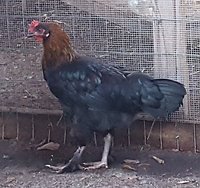- Thread starter
- #5,831
- Sep 18, 2015
- 2,969
- 3,299
- 421
@Chooks man hes only 3 1/2 months and his color is just coming in now. Lots of pin feathers. Any chance he will put more color on. I will get more pics with better lighting
If you could take pictures side, front and rear that always helps. I can tell you I seldom hear Chooks man advise to cull. You can observe the cockerel and ask yourself what do you like about him and what would you like to improve..... depending on the severity of the faults..... is it worth the time?
Does he have good body mass with a rectangular shape or does he have a more triangular shape? Does he have a short back?

Are his legs strong and wide enough apart to give him good support?
Does he have enough copper to pass it on? Copper tufts, copper hackle and saddle, mahogany shoulder. A sprinkling of copper on his chest.
Does he have good color on his legs? His eye?
Look at the bird as a whole. Look over the standard and decide.
I haven't posted the French SOP in a long time but it helps to remind us of what we want to strive toward.
General appearance:
Cock:
Body : strong, fairly long and wide especially near the shoulders which are held high.
Neck : long, fairly strong, tending to curve in on top towards the skull; the hackles are made of many long and abundant feathers covering the shoulders well
Back : long, flat, slightly concave towards the rear
Saddle : large, slightly raised but not rounded, covered with many lancets
Breast : strong and large
Abdomen : well developed
Wings : short , kept close to the body
Tail : strong at its base, quite short, fairly up without going over 45 °
Head : average size, slightly flat and long
Comb : simple, of an average size, with a fairly rough texture. Sharp edges. The lobe not touching the nape
Wattles : average size, red with a fine texture
Ear-lobes : average size, red and long
Face : red coloured with or without down
Eyes : bright, with a orangey-red iris
Beak : Quite strong, slightly hooked and horn-coloured
Shanks : big, without vulture hocks
Tarsi : average size, with some feathers white or lightly pink coloured for all the varieties except for the BLACK, BROWN-RED and BIRCHEN Marans
were grey or dark grey is permitted, although not preferred, for both sexes. Four long and well separated toes with the outer one sparsely feathered.
The claws are white or horn- coloured
Cock : Black-breasted red, with parsimonious red spotting on the breast. Having a black wing triangle. The red markings are not to be yellow or mahogany.
Copper coloured lancets in the neck hackle & the back. Deep red shoulders.
Hen : Black with red hackle markings but without the typical Birchen breast lacing. Very slight red breast marking is acceptable. Green sheen is not required.
Disqualifying Defects
Lack of size; white or yellow ear-lobes; light-coloured or black eyes; tarsi without feathers, black or yellow; triangular body frame;
horizontal or leaning forward body. Cock weighing less than 3 kg; Hen weighing less than 2.2 kg.
Serious defects
Brown-red variety Cock : brown wing bay; any other colour than black on the flights; straw- coloured hackles.
Hen : brown spots on the body.
I copied the SOP from French Marans Club website.
http://www.marans.eu/silhangl.htm#silhouet


